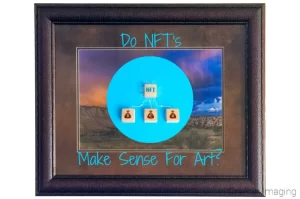Perhaps you’re new into or returning to the art market and you located a piece you want to buy. The next logical thing to do is to buy that piece. Most sellers will only accept their particular nation’s currency. However, there are some sellers, even high-end names, who started accepting cryptocurrency as a form of payment for art. Perhaps you didn’t realize this was possible until checking out. Still, it’s worth discussing. So, we’re jumping into the topic of whether or not you should buy art with cryptocurrency.
A Quick Word About NFT’s

So, let’s briefly address the elephant in the room when it comes to buying art and cryptocurrency: NFT’s. I want to start off by saying I’m not talking about buying art as NFT’s here. That is an entirely different subject which I’ve previously discussed tangentially. You can read up on that article about NFT’s and whether or not they make sense for art using this link. I will not discuss NFT’s and their dubious status in the art world here.
With the bubble bursting on NFT’s a few months ago (at time of writing), I’ve noticed that art circles are drifting away from talking about NFT’s. In fact the only circles still actively discussing the matter are video game companies and Meta (Facebook). Perhaps, with time, this particular subject will become less and less relevant in the general art world. But, with that out of the way, let’s proceed.
A Bit About Cryptocurrencies
Let’s start things off with a brief overview of cryptocurrencies for those who aren’t so familiar with the subject. Let’s start with Wikipedia for something simple and concise.

In computer science, a cryptocurrency, crypto-currency, or crypto is a digital currency that does not rely on any central authority to uphold or maintain it. Instead, transaction and ownership data is stored in a digital ledger using distributed ledger technology, typically a blockchain. However, when a cryptocurrency is issued by a single issuer or minted or created prior to issuance, it is generally considered centralized.
Despite the name, cryptocurrencies are not considered to be currencies in the traditional sense and while varying treatments have been applied to them, including classification as commodities, securities, as well as currencies, cryptocurrencies are generally viewed as a distinct asset class in practice. Unlike paper money, cryptocurrency does not exist in physical form and is typically not issued by a central authority. Cryptocurrencies typically use decentralized control as opposed to a central bank digital currency (CBDC). Traditional asset classes like currencies, commodities, and stocks, as well as macroeconomic factors, have modest exposures to cryptocurrency returns.
The first modern cryptocurrency was Bitcoin, which first released as open-source software in 2009. As of March 2022, there were more than 9,000 other cryptocurrencies in the marketplace, of which more than 70 had a market capitalization exceeding $1 billion.

So, if you didn’t get it from there, cryptocurrencies are digital files created on a computer which are supposed to be seen as an alternate to real money. Where they are entirely digital, you cannot hold them in your hand like you could a dollar. They were supposed to somewhat replace existing national and international currencies online. However, this has not taken place. In general, people treat cryptocurrencies more like commodities (complete with all the hype and speculation) than as currency. This is in spite of some people using and accepting them as currency in exchange for goods and services. Bitcoin was the first and remains the most popular cryptocurrency available. But, despite their popularity in certain circles, Bitcoin and many other cryptocurrencies have yet to see mainstream acceptance.
Will Art Sellers Accept Cryptocurrency as Payment?
This is a very good question and the answer will vary. Some sellers will accept cryptocurrency as payment while others will not. It all comes down to whether or not the particular seller is set up to do something with the cryptocurrency they receive. After all, you cannot go to the store and buy food or gas with cryptocurrency. Landlords do not accept cryptocurrency for rent payments and banks don’t accept it for mortgage payments either. Utility companies don’t accept it for bill payments either. You get the idea?

So, what do you do with a Bitcoin? In order to utilize the money which a particular cryptocurrency represents, you must first liquidate it (sell it to someone else). Cryptocurrency exchange rates fluctuate so you cannot guarantee the price from one day to the next. Also, keep in mind that there are literally thousands of cryptocurrencies available now. The likelihood that a seller will accept something besides the best-known Bitcoin is small. Still, let’s look at different levels of art sellers to determine the likelihood they will accept cryptocurrency as payment.
The High-End Seller

The high end art seller category includes a select group of individuals and businesses. This group includes artists with top-of-their-industry names, world-class galleries and auction houses, and certain art agents/brokers representing the best-of-the-best. You must really work hard and get lucky to join this elite class in the art world. They all command a high reputation and huge price tags because of that reputation. They will not risk tarnishing that reputation for anything.
This is the group best set up to accept cryptocurrency as payment. However, you’ll find this group to be a mixed bag. Some will accept cryptocurrency and they’re more likely to be the auction houses such as Christie’s. This may only be on a case-by-case basis. Other members of the group are much less likely to accept cryptocurrency as doing so will involve more headache than it’s worth to recover real money from the transaction. Plus, cryptocurrency has a somewhat less-than-savory reputation in general. This group won’t want to risk losing money on the fluctuating exchange rate or smear their reputation (perhaps irrevocably) with such an association. Still, it doesn’t hurt to ask.
The Middle End Seller

In the middle end seller category you will find very successful artists in their own right, many art agents and brokers, established galleries, and auction houses with good reputations. Here you’ll find many up-and-coming artists and businesses in the art world. If you work hard on the art market for years, you’ll likely join this group in time.
This group is not yet out of the high-risk high-reward approach. In fact, this might be the most likely group to find cryptocurrency acceptance. They may very well accept cryptocurrency as a way of expanding out and gaining notice. However, this is not guaranteed by any stretch of the imagination. Accepting cryptocurrency is still down to the individual business practices of the specific seller in question. If you want to know about them accepting cryptocurrency, ask. They’ll tell you for sure.
The Low-End Seller

The art market is full of this category. It includes starving and otherwise new artists, new and low-end galleries, and new/low-end auction houses. Art agents and brokers are notably lacking here. Everyone starts off here but some will eventually leave this category for one of the others. Other members are stuck here perpetually for varying reasons.
This group, in general, is nowhere near ready for accepting cryptocurrency. Many here are just starting out. Others are solo operators. They don’t have the time, knowledge, or resources for you to buy art with cryptocurrency. If they do, then that might be a red flag. While it doesn’t hurt to do so, asking might not come off the way you hope with this group. Remember, they are still treading water and need to pay bills with real money. Tread carefully here.
Why Consider Cryptocurrency Then?
If you’d find acceptance of cryptocurrency so spotty, why would you even consider using it? It requires extra effort to obtain (buy or mine). So, why even attempt to buy art with cryptocurrency? There’s only one reason I can think of and it’s anonymity.

If you want to buy a cheap piece of art, you only need walk into a local gallery and pay cash for it. The transaction is completely anonymous. However, if you want to buy a much more expensive piece of art anonymously, that’s where things become complicated. You can’t simply walk in with a briefcase or gym bag full of money and call it good. That kind of transaction is notoriously seen as underhanded. This leaves electronic transactions. However, credit and debit cards remove anonymity from the sale. There’s a card number attached to the sale and that card number is attached to a name: yours.

One of the original ideas behind cryptocurrency was complete anonymity between buyer and seller. Using many of the tools on the internet, you can rather successfully hide your identity from even skilled investigators if you know what you’re doing. Cryptocurrency allows you to mask your financial transactions from them as well. If you truly wish to buy art online anonymously, then cryptocurrency is the way to go. This way, not even the seller will know who you are. Again, this approach is also notoriously seen as underhanded.
Should I Buy Art Using Cryptocurrency?

So, now that we have a foundation, we come back around to the original question and reason for this article. Should you consider buying art using cryptocurrency? From the given information, I lean towards saying no. Cryptocurrency has a shady reputation and acquiring it for the purchase adds an extra layer of complexity. Who wants extra headaches in their life? Not me. Also, we must consider how few sellers will actually accept cryptocurrency. This makes it harder, not easier, to use cryptocurrency to buy art.
I know there are times when you might find it unavoidable. Perhaps the seller at a big-name auction will only accept cryptocurrency in payment. For times that like, then you must use cryptocurrency if you want to buy the art. However, if there’s an alternative, I recommend using the alternative instead. Doing so will make your life easier.
If you want that anonymity in the art market, then cryptocurrency might be your best choice. I sincerely wish you good luck in finding a seller. They do exist. However, as previously discussed, you may have trouble locating one selling something you want.
Conclusion
In conclusion, cryptocurrency is sometimes an option for payment in the art market. Whether or not it is the right choice for you depends upon a lot. What do you want out of the transaction? What will the seller accept? Answering these questions will help you decide if you should buy art using cryptocurrency.
Have you ever bought art using cryptocurrency? I’d love to learn about your experience. Please share what happened in the comments section below. Also please include how satisfied you were with the transaction. This way, we can all learn about this together.




Interesting and insightful article Audrey. I appreciate you sharing your research into this. However, this applies not only to buying art, but other major items as well.
True